Deck 9: Understanding Landscapes
Question
Question
Question
Question
Question
Question
Question
Question
Question
Question
Question
Question
Question
Question
Question
Question
Question
Question
Question
Question
Question
Question
Question
Question
Question
Question
Question
Question
Question
Question
Question
Question
Question
Question
Question
Question
Question
Question
Question
Question
Question
Question
Question
Question
Question
Question
Question
Question
Question
Question
Question
Question
Question
Question
Question
Question
Question
Question
Question
Question
Question
Question
Question
Question
Question
Question
Question
Question
Question
Question
Question
Question
Question
Question
Question
Question
Question
Question
Question
Question

Unlock Deck
Sign up to unlock the cards in this deck!
Unlock Deck
Unlock Deck
1/150
Play
Full screen (f)
Deck 9: Understanding Landscapes
1
Which of the following is not a characteristic of a mineral?
A)Naturally occurring
B)Organic
C)Solid
D)Ordered internal structure
E)Relatively consistent chemical composition
A)Naturally occurring
B)Organic
C)Solid
D)Ordered internal structure
E)Relatively consistent chemical composition
B
2
A sulfide mineral that commonly forms cube-shaped crystals is
A)pyrite.
B)hematite.
C)dolomite.
D)gypsum.
E)halite.
A)pyrite.
B)hematite.
C)dolomite.
D)gypsum.
E)halite.
A
3
The difference between a rock and a mineral is that
A)rocks are inorganic but minerals are organic.
B)rocks can be of a wider variety of origins than minerals.
C)rocks are composed of minerals.
D)rocks are cycled over geologic time but minerals are not.
E)rocks are harder than minerals.
A)rocks are inorganic but minerals are organic.
B)rocks can be of a wider variety of origins than minerals.
C)rocks are composed of minerals.
D)rocks are cycled over geologic time but minerals are not.
E)rocks are harder than minerals.
C
4
Which of the following locations would contain a wide variety of sediment,from large angular blocks to fine rock powder,produced from grinding of the rocks? 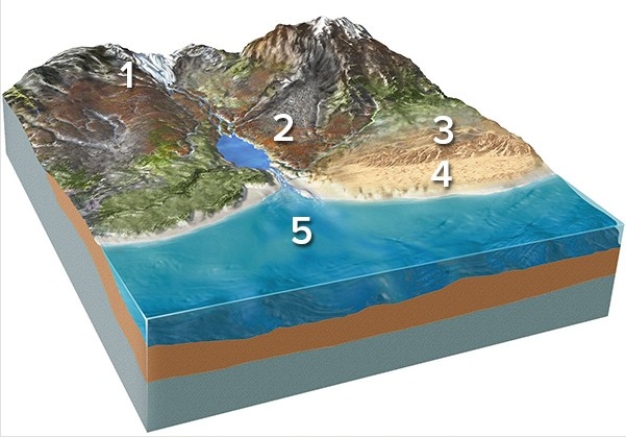
A)Location 1,along the margins of a glacier
B)Location 2,along a steep mountain front
C)Location 3,in sand dunes
D)Location 4,along a beach
E)Location 5,on relatively deep seafloor

A)Location 1,along the margins of a glacier
B)Location 2,along a steep mountain front
C)Location 3,in sand dunes
D)Location 4,along a beach
E)Location 5,on relatively deep seafloor

Unlock Deck
Unlock for access to all 150 flashcards in this deck.
Unlock Deck
k this deck
5
Which of the following is not a mineral?
A)Liquid water
B)Crystals grown in a laboratory
C)Volcanic glass
D)Piece of wood
E)All of these are correct.
A)Liquid water
B)Crystals grown in a laboratory
C)Volcanic glass
D)Piece of wood
E)All of these are correct.

Unlock Deck
Unlock for access to all 150 flashcards in this deck.
Unlock Deck
k this deck
6
A typically green mineral with no cleavage is
A)muscovite.
B)plagioclase feldspar.
C)biotite.
D)quartz.
E)olivine.
A)muscovite.
B)plagioclase feldspar.
C)biotite.
D)quartz.
E)olivine.

Unlock Deck
Unlock for access to all 150 flashcards in this deck.
Unlock Deck
k this deck
7
The very common mineral shown in this photograph is commonly a pink- to cream-colored mineral with wavy,light-colored lines.What mineral is it? 
A)Garnet
B)Quartz
C)Biotite
D)Muscovite
E)Feldspar

A)Garnet
B)Quartz
C)Biotite
D)Muscovite
E)Feldspar

Unlock Deck
Unlock for access to all 150 flashcards in this deck.
Unlock Deck
k this deck
8
A generally a light-colored silicate mineral is
A)quartz.
B)pyroxene.
C)amphibole.
D)biotite.
E)All of these are correct.
A)quartz.
B)pyroxene.
C)amphibole.
D)biotite.
E)All of these are correct.

Unlock Deck
Unlock for access to all 150 flashcards in this deck.
Unlock Deck
k this deck
9
Which of the following locations would contain sand,rounded stones,and broken shells? 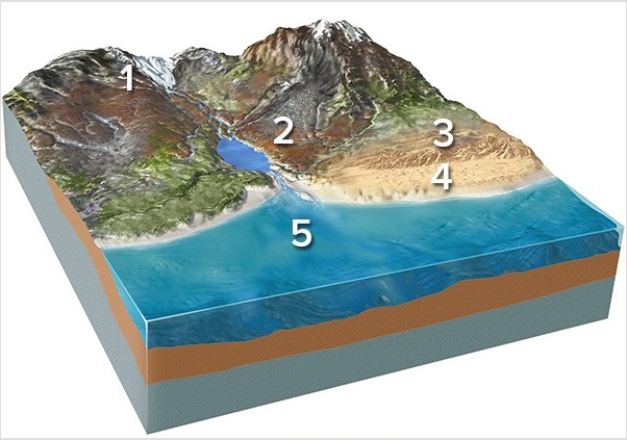
A)Location 1,along the margins of a glacier
B)Location 2,along a steep mountain front
C)Location 3,in sand dunes
D)Location 4,along a beach
E)Location 5,on relatively deep seafloor

A)Location 1,along the margins of a glacier
B)Location 2,along a steep mountain front
C)Location 3,in sand dunes
D)Location 4,along a beach
E)Location 5,on relatively deep seafloor

Unlock Deck
Unlock for access to all 150 flashcards in this deck.
Unlock Deck
k this deck
10
Which of the following locations would contain large,angular rocks that broke away from bedrock and moved downhill? 
A)Location 1,along the margins of a glacier
B)Location 2,along a steep mountain front
C)Location 3,in sand dunes
D)Location 4,along a beach
E)Location 5,on relatively deep seafloor

A)Location 1,along the margins of a glacier
B)Location 2,along a steep mountain front
C)Location 3,in sand dunes
D)Location 4,along a beach
E)Location 5,on relatively deep seafloor

Unlock Deck
Unlock for access to all 150 flashcards in this deck.
Unlock Deck
k this deck
11
Which of the following is not composed of calcium carbonate?
A)Calcite
B)Pyrite
C)Marble
D)Shells
E)Limestone
A)Calcite
B)Pyrite
C)Marble
D)Shells
E)Limestone

Unlock Deck
Unlock for access to all 150 flashcards in this deck.
Unlock Deck
k this deck
12
A mineral that is light colored,transparent,and fractures rather than cleaves is
A)garnet.
B)quartz.
C)biotite.
D)muscovite.
E)feldspar.
A)garnet.
B)quartz.
C)biotite.
D)muscovite.
E)feldspar.

Unlock Deck
Unlock for access to all 150 flashcards in this deck.
Unlock Deck
k this deck
13
The very common mineral shown in this photograph is light colored,transparent,and fractures rather than cleaves.What mineral is it? 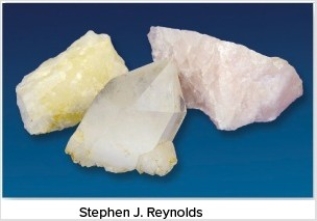
A)Garnet
B)Quartz
C)Biotite
D)Muscovite
E)Feldspar

A)Garnet
B)Quartz
C)Biotite
D)Muscovite
E)Feldspar

Unlock Deck
Unlock for access to all 150 flashcards in this deck.
Unlock Deck
k this deck
14
A commonly pinkish mineral with light-colored wavy lines is
A)quartz.
B)potassium feldspar.
C)pyroxene.
D)amphibole.
E)olivine.
A)quartz.
B)potassium feldspar.
C)pyroxene.
D)amphibole.
E)olivine.

Unlock Deck
Unlock for access to all 150 flashcards in this deck.
Unlock Deck
k this deck
15
The very common carbonate mineral shown here that is a clear to light-gray color is 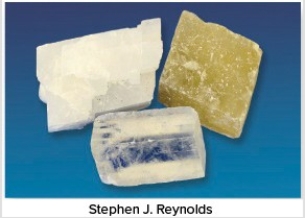
A)calcite.
B)dolomite.
C)hematite.
D)magnetite.
E)pyrite.

A)calcite.
B)dolomite.
C)hematite.
D)magnetite.
E)pyrite.

Unlock Deck
Unlock for access to all 150 flashcards in this deck.
Unlock Deck
k this deck
16
Which of the following locations would most likely contain large,angular rocks? 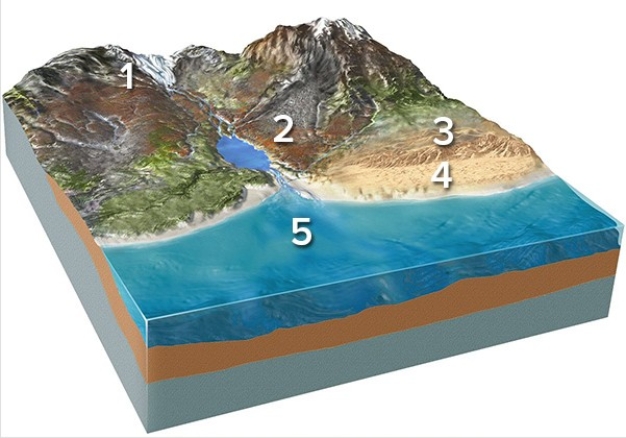
A)Location 1,along the margins of a glacier
B)Location 2,along a steep mountain front
C)Location 3,in sand dunes
D)Locations 1 and 2
E)Locations 2 and 3

A)Location 1,along the margins of a glacier
B)Location 2,along a steep mountain front
C)Location 3,in sand dunes
D)Locations 1 and 2
E)Locations 2 and 3

Unlock Deck
Unlock for access to all 150 flashcards in this deck.
Unlock Deck
k this deck
17
Which of the following locations would contain mud and the remains of small creatures? 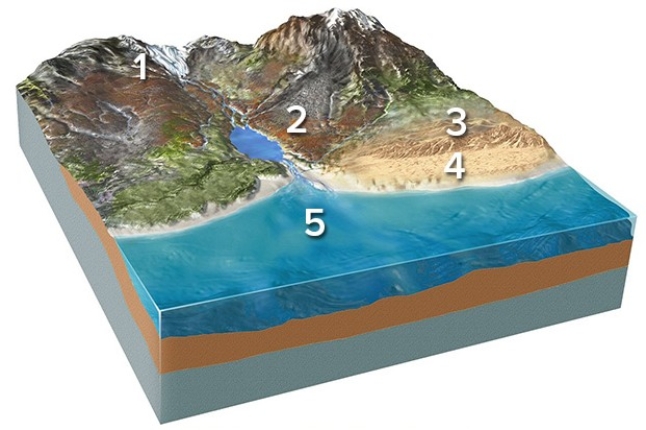
A)Location 1,along the margins of a glacier
B)Location 2,along a steep mountain front
C)Location 3,in sand dunes
D)Location 4,along a beach
E)Location 5,on relatively deep seafloor

A)Location 1,along the margins of a glacier
B)Location 2,along a steep mountain front
C)Location 3,in sand dunes
D)Location 4,along a beach
E)Location 5,on relatively deep seafloor

Unlock Deck
Unlock for access to all 150 flashcards in this deck.
Unlock Deck
k this deck
18
The mineral shown in this photograph is 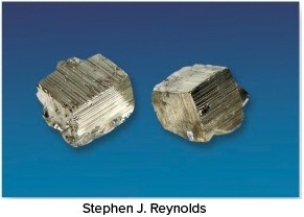
A)pyrite.
B)hematite.
C)dolomite.
D)gypsum.
E)halite.

A)pyrite.
B)hematite.
C)dolomite.
D)gypsum.
E)halite.

Unlock Deck
Unlock for access to all 150 flashcards in this deck.
Unlock Deck
k this deck
19
The main type of rocks in the Peninsular Ranges of Southern California and Mexico is
A)volcanic rocks erupted from a large volcano.
B)granite and metamorphic rocks that formed at depth.
C)flat-lying sedimentary rocks.
D)unconsolidated sand and gravel.
A)volcanic rocks erupted from a large volcano.
B)granite and metamorphic rocks that formed at depth.
C)flat-lying sedimentary rocks.
D)unconsolidated sand and gravel.

Unlock Deck
Unlock for access to all 150 flashcards in this deck.
Unlock Deck
k this deck
20
Which of the following is a mineral?
A)Ice
B)Crystals grown in a laboratory
C)Volcanic glass
D)Material with crystals of different chemical compounds
E)None of these are correct.
A)Ice
B)Crystals grown in a laboratory
C)Volcanic glass
D)Material with crystals of different chemical compounds
E)None of these are correct.

Unlock Deck
Unlock for access to all 150 flashcards in this deck.
Unlock Deck
k this deck
21
Which of the following locations would most likely contain a high percentage of sand? 
A)Location 2,along a steep mountain front
B)Location 3,in sand dunes
C)Location 4,along a beach
D)Locations 2 and 3
E)Locations 3 and 4

A)Location 2,along a steep mountain front
B)Location 3,in sand dunes
C)Location 4,along a beach
D)Locations 2 and 3
E)Locations 3 and 4

Unlock Deck
Unlock for access to all 150 flashcards in this deck.
Unlock Deck
k this deck
22
Uplift can occur during the rock cycle
A)only after deformation and metamorphism.
B)only after melting and solidification.
C)only after metamorphism or solidification.
D)at any point after burial.
A)only after deformation and metamorphism.
B)only after melting and solidification.
C)only after metamorphism or solidification.
D)at any point after burial.

Unlock Deck
Unlock for access to all 150 flashcards in this deck.
Unlock Deck
k this deck
23
Which of the following surface environments is the most likely site for deposits in this photograph? 
A)Steep mountain front
B)River channel
C)Sand dunes
D)Beach
E)Lake

A)Steep mountain front
B)River channel
C)Sand dunes
D)Beach
E)Lake

Unlock Deck
Unlock for access to all 150 flashcards in this deck.
Unlock Deck
k this deck
24
Which of the following locations would form a metamorphic rock? 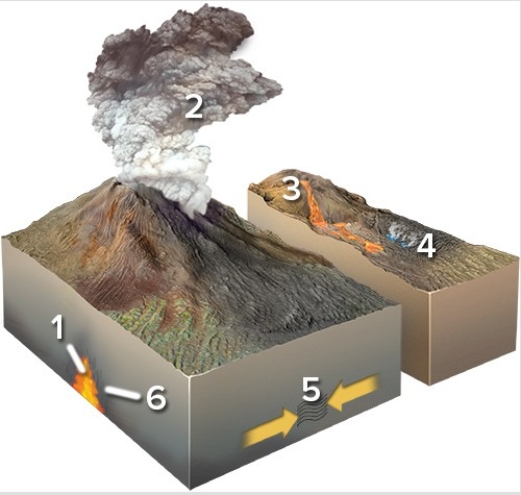
A)Locations 1 and 2
B)Locations 2 and 3
C)Locations 3 and 4
D)Locations 1,2,and 3
E)Locations 5 and 6

A)Locations 1 and 2
B)Locations 2 and 3
C)Locations 3 and 4
D)Locations 1,2,and 3
E)Locations 5 and 6

Unlock Deck
Unlock for access to all 150 flashcards in this deck.
Unlock Deck
k this deck
25
Which of the following is not a typical environment in which a metamorphic rock forms?
A)Solidification of lava
B)Heating adjacent to underground magma
C)Squeezing by tectonic forces
D)Burial to great depths
A)Solidification of lava
B)Heating adjacent to underground magma
C)Squeezing by tectonic forces
D)Burial to great depths

Unlock Deck
Unlock for access to all 150 flashcards in this deck.
Unlock Deck
k this deck
26
The type of rock shown in this photograph is 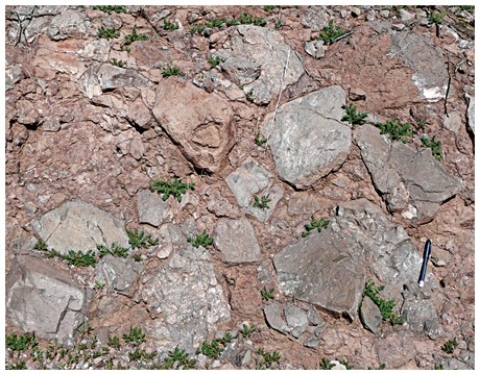
A)conglomerate.
B)breccia.
C)sandstone.
D)shale.

A)conglomerate.
B)breccia.
C)sandstone.
D)shale.

Unlock Deck
Unlock for access to all 150 flashcards in this deck.
Unlock Deck
k this deck
27
Which of the following is not one of the main families of rocks?
A)Sedimentary
B)Igneous
C)Metamorphic
D)Meteorites
A)Sedimentary
B)Igneous
C)Metamorphic
D)Meteorites

Unlock Deck
Unlock for access to all 150 flashcards in this deck.
Unlock Deck
k this deck
28
Which of the following is not an environment in which an igneous rock forms?
A)Explosive eruption of volcanic ash
B)Cooling and solidification of lava
C)Solidification of magma at depth
D)Intense squeezing from tectonic forces
E)All of these are environments that form igneous rock.
A)Explosive eruption of volcanic ash
B)Cooling and solidification of lava
C)Solidification of magma at depth
D)Intense squeezing from tectonic forces
E)All of these are environments that form igneous rock.

Unlock Deck
Unlock for access to all 150 flashcards in this deck.
Unlock Deck
k this deck
29
Which of the following locations would form a hydrothermal rock? 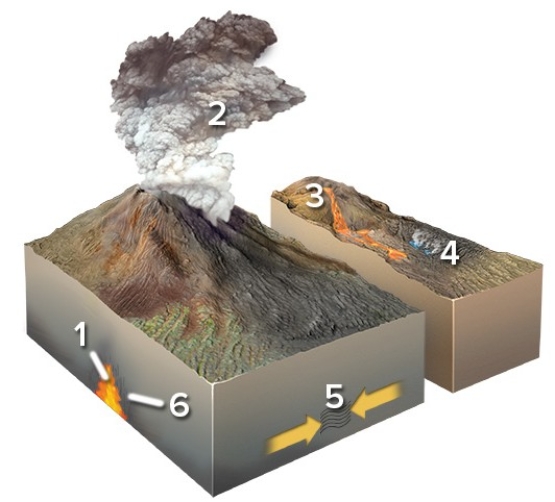
A)Location 1
B)Location 2
C)Location 3
D)Location 4
E)Locations 2 and 3

A)Location 1
B)Location 2
C)Location 3
D)Location 4
E)Locations 2 and 3

Unlock Deck
Unlock for access to all 150 flashcards in this deck.
Unlock Deck
k this deck
30
Which of the following locations would form an igneous rock? 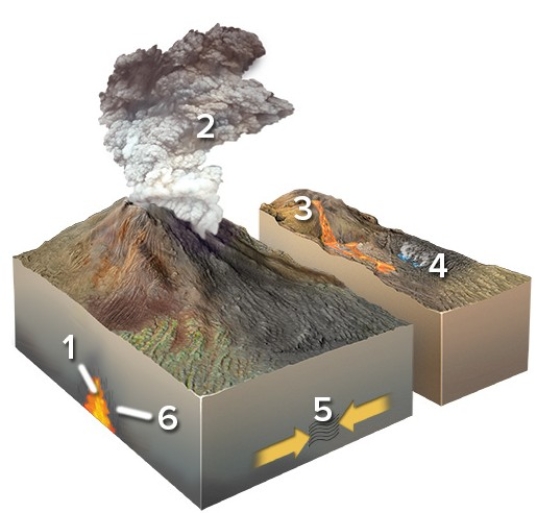
A)Locations 1 and 2
B)Locations 2 and 3
C)Locations 3 and 4
D)Locations 1,2,and 3
E)Locations 5 and 6

A)Locations 1 and 2
B)Locations 2 and 3
C)Locations 3 and 4
D)Locations 1,2,and 3
E)Locations 5 and 6

Unlock Deck
Unlock for access to all 150 flashcards in this deck.
Unlock Deck
k this deck
31
The type of rock that the materials shown in this photograph would produce is 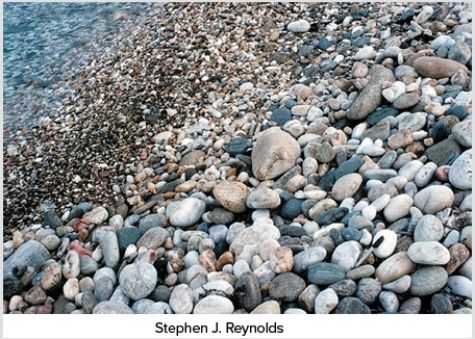
A)sedimentary.
B)igneous.
C)metamorphic.
D)hydrothermal.

A)sedimentary.
B)igneous.
C)metamorphic.
D)hydrothermal.

Unlock Deck
Unlock for access to all 150 flashcards in this deck.
Unlock Deck
k this deck
32
Which of the following surface environments is the most likely site for deposits in this photograph? 
A)Steep mountain front
B)Glacier
C)Sand dunes
D)Beach

A)Steep mountain front
B)Glacier
C)Sand dunes
D)Beach

Unlock Deck
Unlock for access to all 150 flashcards in this deck.
Unlock Deck
k this deck
33
Which of the following best indicates a location where sediment is deposited but not eroded? 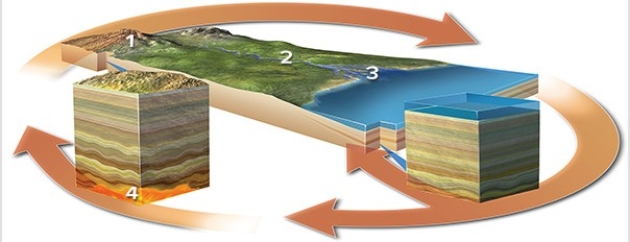
A)Location 1
B)Location 2
C)Location 3
D)Location 4

A)Location 1
B)Location 2
C)Location 3
D)Location 4

Unlock Deck
Unlock for access to all 150 flashcards in this deck.
Unlock Deck
k this deck
34
The type of rock shown in this photograph is 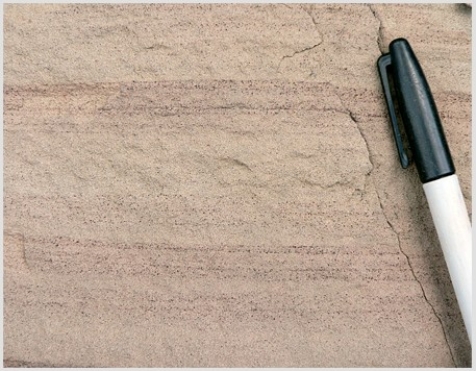
A)conglomerate.
B)breccia.
C)sandstone.
D)shale.

A)conglomerate.
B)breccia.
C)sandstone.
D)shale.

Unlock Deck
Unlock for access to all 150 flashcards in this deck.
Unlock Deck
k this deck
35
Which of the following locations would have weathering of bedrock or loose sediment? 
A)Location 1
B)Location 2
C)Location 3
D)Location 4
E)Locations 1 and 2

A)Location 1
B)Location 2
C)Location 3
D)Location 4
E)Locations 1 and 2

Unlock Deck
Unlock for access to all 150 flashcards in this deck.
Unlock Deck
k this deck
36
Which of the following does not list processes in an order consistent with a logical progression through the rock cycle?
A)Weathering,erosion,deposition
B)Solidification,melting,burial
C)Erosion,deposition,burial
D)Uplift,weathering,erosion
E)Burial,metamorphism,melting
A)Weathering,erosion,deposition
B)Solidification,melting,burial
C)Erosion,deposition,burial
D)Uplift,weathering,erosion
E)Burial,metamorphism,melting

Unlock Deck
Unlock for access to all 150 flashcards in this deck.
Unlock Deck
k this deck
37
Which of the following settings would result in the formation of igneous rocks? 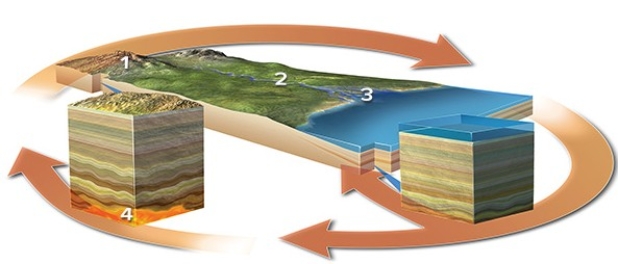
A)Location 1
B)Location 2
C)Location 3
D)Location 4

A)Location 1
B)Location 2
C)Location 3
D)Location 4

Unlock Deck
Unlock for access to all 150 flashcards in this deck.
Unlock Deck
k this deck
38
Which of the following best indicates a location where sediment is transported? 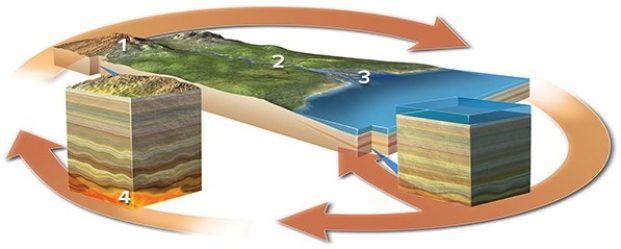
A)Location 1
B)Location 2
C)Location 3
D)Location 4

A)Location 1
B)Location 2
C)Location 3
D)Location 4

Unlock Deck
Unlock for access to all 150 flashcards in this deck.
Unlock Deck
k this deck
39
Which of the following is not a typical environment in which a sedimentary rock forms?
A)Beside glaciers
B)River channels
C)Heating next to a magma
D)Deep seafloor
E)Shoreline of a lake
A)Beside glaciers
B)River channels
C)Heating next to a magma
D)Deep seafloor
E)Shoreline of a lake

Unlock Deck
Unlock for access to all 150 flashcards in this deck.
Unlock Deck
k this deck
40
According to the rock cycle,sediment that is being transported by a river could become a metamorphic rock after
A)uplift and weathering.
B)melting and solidification.
C)deposition and burial.
D)solidification and uplift.
A)uplift and weathering.
B)melting and solidification.
C)deposition and burial.
D)solidification and uplift.

Unlock Deck
Unlock for access to all 150 flashcards in this deck.
Unlock Deck
k this deck
41
What does this welded texture indicate about the formation of this rock? 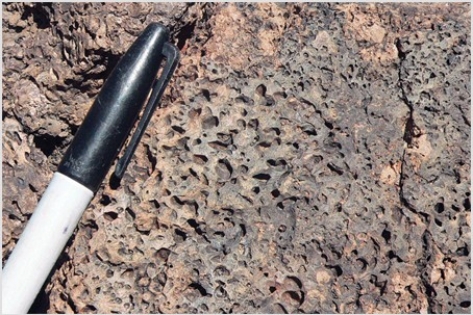
A)It formed from an explosive pyroclastic eruption.
B)The rock solidified at great depth.
C)The magma formed some crystals before rising closer to the surface and solidifying.
D)The magma had abundant dissolved gas.

A)It formed from an explosive pyroclastic eruption.
B)The rock solidified at great depth.
C)The magma formed some crystals before rising closer to the surface and solidifying.
D)The magma had abundant dissolved gas.

Unlock Deck
Unlock for access to all 150 flashcards in this deck.
Unlock Deck
k this deck
42
Which of the following is not involved in turning some sediment into sedimentary rock?
A)Burial
B)Compaction
C)Cementation
D)Metamorphism
E)All of these are involved.
A)Burial
B)Compaction
C)Cementation
D)Metamorphism
E)All of these are involved.

Unlock Deck
Unlock for access to all 150 flashcards in this deck.
Unlock Deck
k this deck
43
The site on the accompanying figure that would most likely form a rock that has a welded texture is 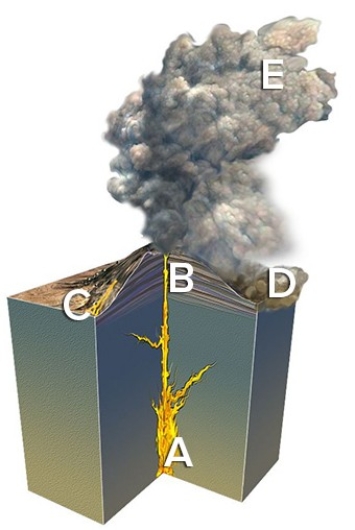
A)A.
B)B.
C)C.
D)D.
E)E.

A)A.
B)B.
C)C.
D)D.
E)E.

Unlock Deck
Unlock for access to all 150 flashcards in this deck.
Unlock Deck
k this deck
44
The main difference between conglomerate and breccia is
A)the size of the clasts.
B)the shape of the clasts.
C)the sorting of the clasts.
D)the kind of cement.
E)All of these are correct.
A)the size of the clasts.
B)the shape of the clasts.
C)the sorting of the clasts.
D)the kind of cement.
E)All of these are correct.

Unlock Deck
Unlock for access to all 150 flashcards in this deck.
Unlock Deck
k this deck
45
Which of the following rocks is composed of the smallest sedimentary clasts?
A)Breccia
B)Conglomerate
C)Shale
D)Sandstone
A)Breccia
B)Conglomerate
C)Shale
D)Sandstone

Unlock Deck
Unlock for access to all 150 flashcards in this deck.
Unlock Deck
k this deck
46
What texture is displayed by the igneous rock in this photograph? 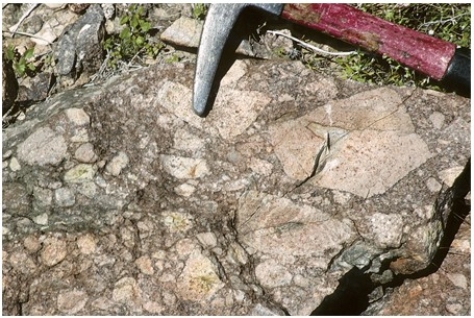
A)Vesicles
B)Breccia
C)Porphyritic
D)Glassy
E)None of these are correct.

A)Vesicles
B)Breccia
C)Porphyritic
D)Glassy
E)None of these are correct.

Unlock Deck
Unlock for access to all 150 flashcards in this deck.
Unlock Deck
k this deck
47
A finely crystalline or glassy igneous texture indicates that
A)there was a lot of gas in the magma.
B)the rock cooled quickly.
C)the rock broke apart as it flowed.
D)the rock cooled slowly.
E)the ash and pumice were hot and became compacted.
A)there was a lot of gas in the magma.
B)the rock cooled quickly.
C)the rock broke apart as it flowed.
D)the rock cooled slowly.
E)the ash and pumice were hot and became compacted.

Unlock Deck
Unlock for access to all 150 flashcards in this deck.
Unlock Deck
k this deck
48
The natural sediments that hold clasts together precipitate in the empty pore spaces after compaction.Those precipitates come from
A)water containing dissolved materials.
B)outward growth of the original clasts.
C)the alignment of clay particles.
A)water containing dissolved materials.
B)outward growth of the original clasts.
C)the alignment of clay particles.

Unlock Deck
Unlock for access to all 150 flashcards in this deck.
Unlock Deck
k this deck
49
What does this texture indicate about the formation of this rock? 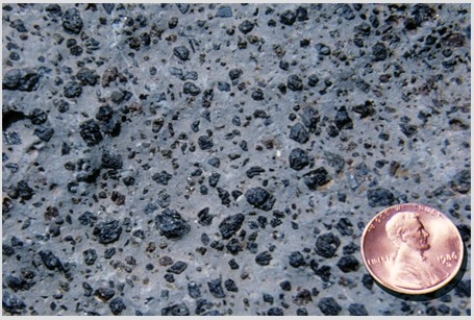
A)It formed from an explosive pyroclastic eruption.
B)The rock solidified at great depth.
C)The magma formed some crystals before rising closer to the surface and solidifying.
D)The magma had abundant dissolved gas.

A)It formed from an explosive pyroclastic eruption.
B)The rock solidified at great depth.
C)The magma formed some crystals before rising closer to the surface and solidifying.
D)The magma had abundant dissolved gas.

Unlock Deck
Unlock for access to all 150 flashcards in this deck.
Unlock Deck
k this deck
50
What texture is displayed by the igneous rock in this photograph? 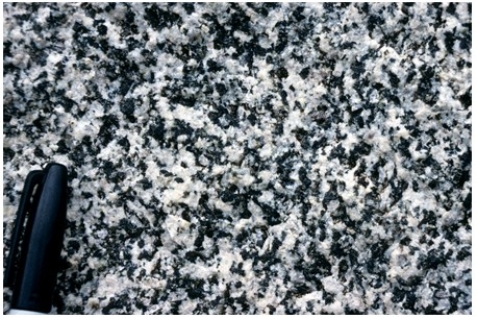
A)Vesicles
B)Breccia
C)Porphyritic
D)Glassy
E)None of these are correct.

A)Vesicles
B)Breccia
C)Porphyritic
D)Glassy
E)None of these are correct.

Unlock Deck
Unlock for access to all 150 flashcards in this deck.
Unlock Deck
k this deck
51
What texture is displayed by the igneous rock in this photograph? 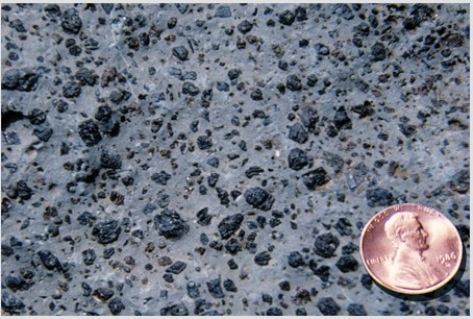
A)Vesicles
B)Breccia
C)Porphyritic
D)Glassy
E)None of these are correct.

A)Vesicles
B)Breccia
C)Porphyritic
D)Glassy
E)None of these are correct.

Unlock Deck
Unlock for access to all 150 flashcards in this deck.
Unlock Deck
k this deck
52
The site on the accompanying figure that would most likely form a rock that is glassy with no volcanic ash is 
A)A.
B)B.
C)C.
D)D.
E)E.

A)A.
B)B.
C)C.
D)D.
E)E.

Unlock Deck
Unlock for access to all 150 flashcards in this deck.
Unlock Deck
k this deck
53
The site on the figure below that would most likely form a rock with large crystals is 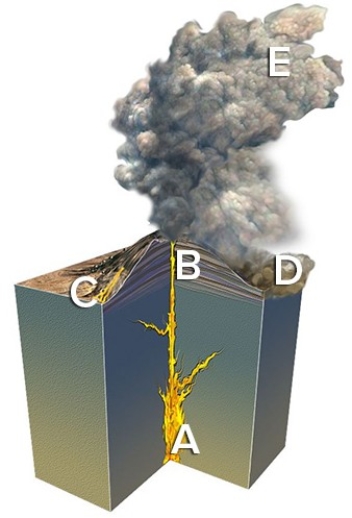
A)A.
B)B.
C)C.
D)D.
E)E.

A)A.
B)B.
C)C.
D)D.
E)E.

Unlock Deck
Unlock for access to all 150 flashcards in this deck.
Unlock Deck
k this deck
54
The site on the accompanying figure that would most likely form a rock that has a nonwelded texture with many fine particles is 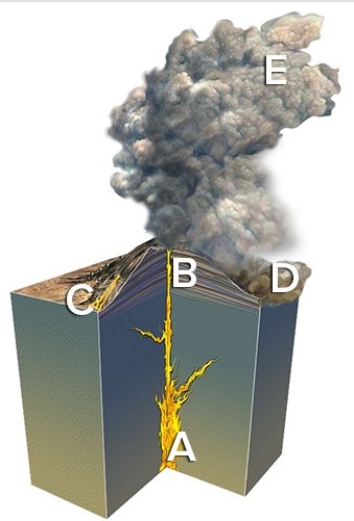
A)A.
B)B.
C)C.
D)D.
E)E.

A)A.
B)B.
C)C.
D)D.
E)E.

Unlock Deck
Unlock for access to all 150 flashcards in this deck.
Unlock Deck
k this deck
55
Which of the following is not a common type of cement in sedimentary rocks?
A)Calcite
B)Pyroxene
C)Silica
D)Iron-oxide minerals
A)Calcite
B)Pyroxene
C)Silica
D)Iron-oxide minerals

Unlock Deck
Unlock for access to all 150 flashcards in this deck.
Unlock Deck
k this deck
56
The type of rock shown in this photograph is 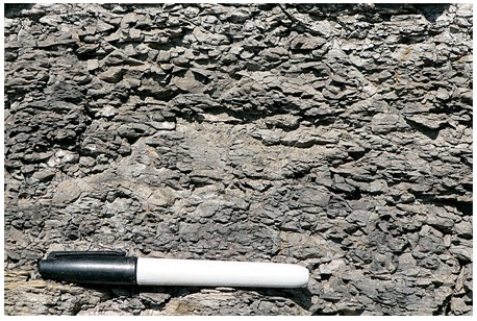
A)conglomerate.
B)breccia.
C)sandstone.
D)shale.

A)conglomerate.
B)breccia.
C)sandstone.
D)shale.

Unlock Deck
Unlock for access to all 150 flashcards in this deck.
Unlock Deck
k this deck
57
The rock shown here,with sediment just visible to the naked eye,is a 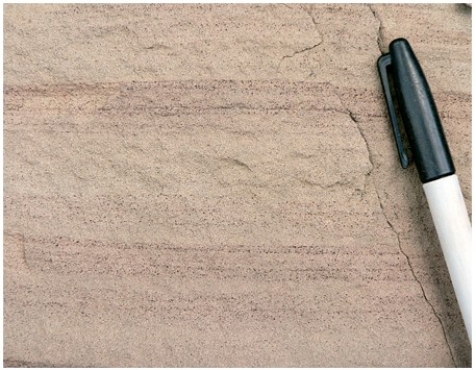
A)sandstone.
B)shale.
C)conglomerate.

A)sandstone.
B)shale.
C)conglomerate.

Unlock Deck
Unlock for access to all 150 flashcards in this deck.
Unlock Deck
k this deck
58
What does this texture indicate about the formation of this rock? 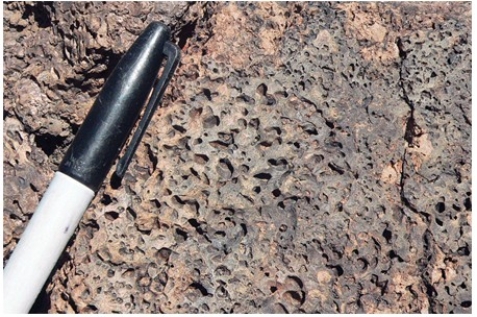
A)It formed from an explosive pyroclastic eruption.
B)The rock solidified at great depth.
C)The magma formed some crystals before rising closer to the surface and solidifying.
D)The magma had abundant dissolved gas.

A)It formed from an explosive pyroclastic eruption.
B)The rock solidified at great depth.
C)The magma formed some crystals before rising closer to the surface and solidifying.
D)The magma had abundant dissolved gas.

Unlock Deck
Unlock for access to all 150 flashcards in this deck.
Unlock Deck
k this deck
59
Which of the following statements is not true about clastic sedimentary rocks?
A)Clasts in a conglomerate or breccias can be different rock types or can be all the same rock type.
B)To be called a sandstone,quartz must make up more than 95 percent of the grains.
C)The amount of pore space decreases as a sand is compacted into sandstone.
D)The natural cement that holds sedimentary rocks together is composed of dissolved minerals that precipitate.
A)Clasts in a conglomerate or breccias can be different rock types or can be all the same rock type.
B)To be called a sandstone,quartz must make up more than 95 percent of the grains.
C)The amount of pore space decreases as a sand is compacted into sandstone.
D)The natural cement that holds sedimentary rocks together is composed of dissolved minerals that precipitate.

Unlock Deck
Unlock for access to all 150 flashcards in this deck.
Unlock Deck
k this deck
60
The site on the figure below that would mostly likely form a rock that is fine grained (has small crystals but is not glassy)is 
A)A.
B)B.
C)C.
D)D.
E)E.

A)A.
B)B.
C)C.
D)D.
E)E.

Unlock Deck
Unlock for access to all 150 flashcards in this deck.
Unlock Deck
k this deck
61
Coarsely crystalline igneous textures indicate that
A)there was a lot of gas in the magma.
B)the rock cooled quickly.
C)the rock broke apart as it flowed.
D)the rock cooled slowly.
E)the ash and pumice were hot and became compacted.
A)there was a lot of gas in the magma.
B)the rock cooled quickly.
C)the rock broke apart as it flowed.
D)the rock cooled slowly.
E)the ash and pumice were hot and became compacted.

Unlock Deck
Unlock for access to all 150 flashcards in this deck.
Unlock Deck
k this deck
62
What type of metamorphism would occur in this setting? 
A)Regional metamorphism
B)Contact metamorphism
C)Subduction
D)Normal faulting

A)Regional metamorphism
B)Contact metamorphism
C)Subduction
D)Normal faulting

Unlock Deck
Unlock for access to all 150 flashcards in this deck.
Unlock Deck
k this deck
63
A welded igneous texture indicates that
A)there was a lot of gas in the magma.
B)the rock cooled quickly.
C)the rock broke apart as it flowed.
D)the rock cooled slowly.
E)the ash and pumice were hot and became compacted.
A)there was a lot of gas in the magma.
B)the rock cooled quickly.
C)the rock broke apart as it flowed.
D)the rock cooled slowly.
E)the ash and pumice were hot and became compacted.

Unlock Deck
Unlock for access to all 150 flashcards in this deck.
Unlock Deck
k this deck
64
Which of the following is a common metamorphic process?
A)Deforming objects into new shapes
B)Rotation of minerals into a common orientation
C)Remobilization of chemical constituents into light and dark bands
D)Dissolving some parts of the rock and carrying the material away
E)All of these are correct.
A)Deforming objects into new shapes
B)Rotation of minerals into a common orientation
C)Remobilization of chemical constituents into light and dark bands
D)Dissolving some parts of the rock and carrying the material away
E)All of these are correct.

Unlock Deck
Unlock for access to all 150 flashcards in this deck.
Unlock Deck
k this deck
65
A vesicular igneous texture indicates that
A)there was a lot of gas in the magma.
B)the rock cooled quickly.
C)the rock broke apart as it flowed.
D)the rock cooled slowly.
E)the ash and pumice were hot and became compacted.
A)there was a lot of gas in the magma.
B)the rock cooled quickly.
C)the rock broke apart as it flowed.
D)the rock cooled slowly.
E)the ash and pumice were hot and became compacted.

Unlock Deck
Unlock for access to all 150 flashcards in this deck.
Unlock Deck
k this deck
66
A volcanic breccia texture indicates that
A)there was a lot of gas in the magma.
B)the rock cooled quickly.
C)the rock broke apart as it flowed.
D)the rock cooled slowly.
E)the ash and pumice were hot and became compacted.
A)there was a lot of gas in the magma.
B)the rock cooled quickly.
C)the rock broke apart as it flowed.
D)the rock cooled slowly.
E)the ash and pumice were hot and became compacted.

Unlock Deck
Unlock for access to all 150 flashcards in this deck.
Unlock Deck
k this deck
67
Which of the following matches a sedimentary rock with a possible metamorphic equivalent?
A)Sandstone - phyllite
B)Basalt - marble
C)Limestone - quartzite
D)Shale - slate
E)None of these are correct.
A)Sandstone - phyllite
B)Basalt - marble
C)Limestone - quartzite
D)Shale - slate
E)None of these are correct.

Unlock Deck
Unlock for access to all 150 flashcards in this deck.
Unlock Deck
k this deck
68
Which of the following igneous rocks can be composed of fragments?
A)Tuff
B)Scoria
C)Volcanic breccia
D)All of these are correct.
A)Tuff
B)Scoria
C)Volcanic breccia
D)All of these are correct.

Unlock Deck
Unlock for access to all 150 flashcards in this deck.
Unlock Deck
k this deck
69
Which of the following photographs depicts an igneous rock where the magma cooled slowly at first and then had fast cooling?
A)

B)

C)

D)

A)

B)

C)

D)


Unlock Deck
Unlock for access to all 150 flashcards in this deck.
Unlock Deck
k this deck
70
Which of the following rock photographs depicts a felsic igneous rock?
A)
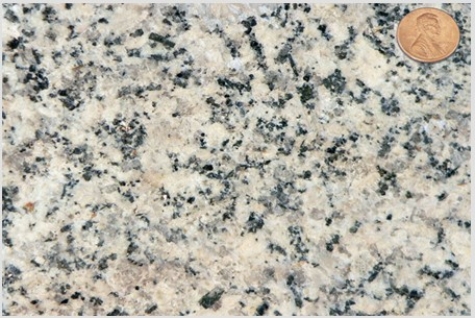
B)

C)
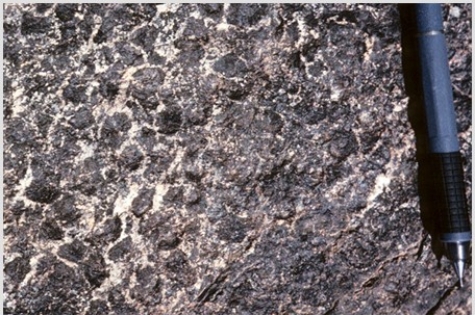
D)
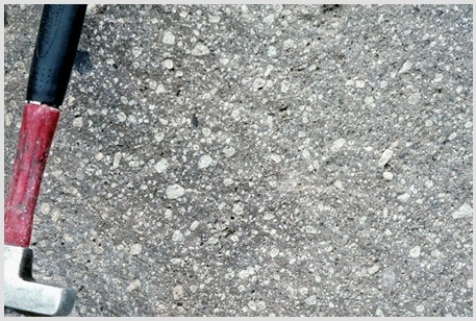
A)

B)

C)

D)


Unlock Deck
Unlock for access to all 150 flashcards in this deck.
Unlock Deck
k this deck
71
Deep Check
In metamorphism,after a rock is heated,
A)it will be deformed.
B)it may or may not be deformed.
C)it will develop a new texture.
D)it may or may not develop a new texture.
E)it will be deformed and it may or may not develop a new texture.
In metamorphism,after a rock is heated,
A)it will be deformed.
B)it may or may not be deformed.
C)it will develop a new texture.
D)it may or may not develop a new texture.
E)it will be deformed and it may or may not develop a new texture.

Unlock Deck
Unlock for access to all 150 flashcards in this deck.
Unlock Deck
k this deck
72
Which of the following rocks cannot be metamorphosed?
A)Shale
B)Sandstone
C)Limestone
D)All of these can be metamorphosed.
A)Shale
B)Sandstone
C)Limestone
D)All of these can be metamorphosed.

Unlock Deck
Unlock for access to all 150 flashcards in this deck.
Unlock Deck
k this deck
73
Which of the following rock types requires dissolved gas in the magma?
A)Granite
B)Pumice
C)Gabbro
D)Diorite
E)Andesite
A)Granite
B)Pumice
C)Gabbro
D)Diorite
E)Andesite

Unlock Deck
Unlock for access to all 150 flashcards in this deck.
Unlock Deck
k this deck
74
The type of metamorphism that would occur in this setting is 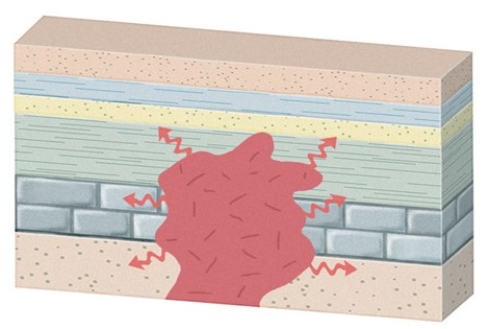
A)regional metamorphism.
B)contact metamorphism.
C)subduction.
D)thrust faulting.

A)regional metamorphism.
B)contact metamorphism.
C)subduction.
D)thrust faulting.

Unlock Deck
Unlock for access to all 150 flashcards in this deck.
Unlock Deck
k this deck
75
Which of the following does not match a sedimentary rock with a possible metamorphic equivalent?
A)Sandstone - quartzite
B)Limestone - marble
C)Shale - schist
D)Shale - gneiss
E)All of these are correct matches.
A)Sandstone - quartzite
B)Limestone - marble
C)Shale - schist
D)Shale - gneiss
E)All of these are correct matches.

Unlock Deck
Unlock for access to all 150 flashcards in this deck.
Unlock Deck
k this deck
76
The type of feature shown in this photograph is 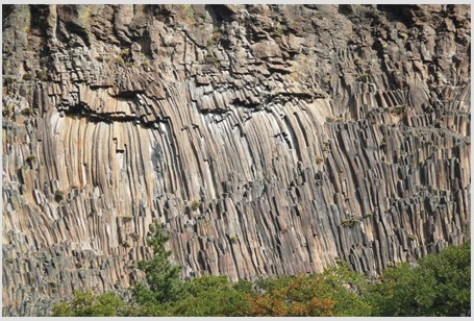
A)fault scarp.
B)columnar joints.
C)shear zone.
D)folded metamorphic rocks.

A)fault scarp.
B)columnar joints.
C)shear zone.
D)folded metamorphic rocks.

Unlock Deck
Unlock for access to all 150 flashcards in this deck.
Unlock Deck
k this deck
77
Which of the following is a typical way in which shale is expressed in the landscape?
A)Soft slopes covered by small,loose chips
B)Slopes covered by loose debris from overlying rocks
C)Valleys and other low areas carved into the landscape
D)Badlands
E)All of these are correct.
A)Soft slopes covered by small,loose chips
B)Slopes covered by loose debris from overlying rocks
C)Valleys and other low areas carved into the landscape
D)Badlands
E)All of these are correct.

Unlock Deck
Unlock for access to all 150 flashcards in this deck.
Unlock Deck
k this deck
78
Which of the following rock photographs depicts an igneous rock that trapped gas?
A)
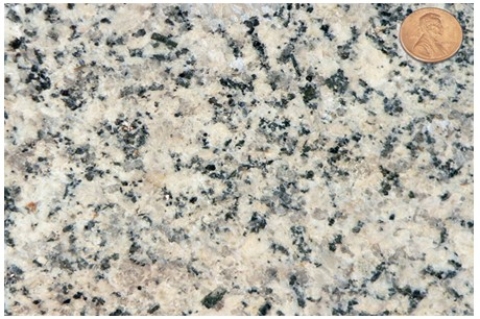
B)
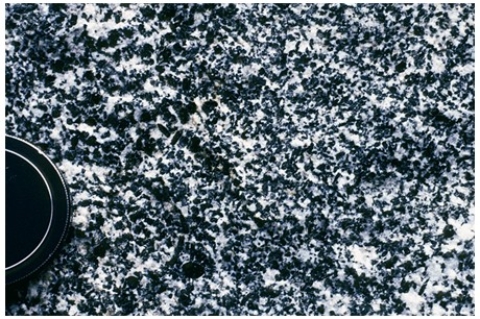
C)
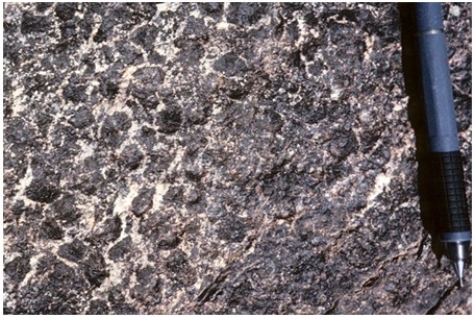
D)
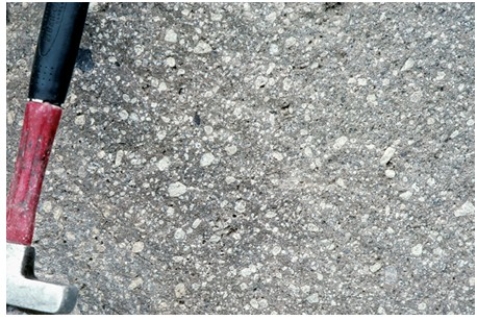
A)

B)

C)

D)


Unlock Deck
Unlock for access to all 150 flashcards in this deck.
Unlock Deck
k this deck
79
Because shales are easily eroded,the areas where they are exposed typically
A)have soft slopes and soil cover.
B)are covered in angular boulders and cobbles.
C)form steep cliffs.
A)have soft slopes and soil cover.
B)are covered in angular boulders and cobbles.
C)form steep cliffs.

Unlock Deck
Unlock for access to all 150 flashcards in this deck.
Unlock Deck
k this deck
80
A porphyritic igneous texture indicates that
A)there was water in the magma.
B)the rock cooled slowly and then quickly.
C)the rock broke apart as it flowed.
D)the rock cooled slowly.
E)the ash and pumice were hot and became compacted.
A)there was water in the magma.
B)the rock cooled slowly and then quickly.
C)the rock broke apart as it flowed.
D)the rock cooled slowly.
E)the ash and pumice were hot and became compacted.

Unlock Deck
Unlock for access to all 150 flashcards in this deck.
Unlock Deck
k this deck



